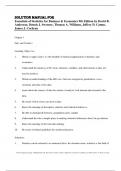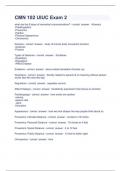SOLUTION MANUAL FOR
Essentials of Statistics for Business & Economics 9th Edition by David R.
Anderson, Dennis J. Sweeney, Thomas A. Williams, Jeffrey D. Camm,
James J. Cochran
Chapter 1
Data and Statistics
N
Learning Objectives
U
1. Obtain an appreciation for the breadth of statistical applications in business and
economics.
R
2. Understand the meaning of the terms elements, variables, and observations as they are
SE
used in statistics.
3. Obtain an understanding of the difference between categorical, quantitative, cross-
sectional, and time-series data.
D
4. Learn about the sources of data for statistical analysis both internal and external to the
firm.
O
5. Be aware of how errors can arise in data.
6. Know the meaning of descriptive statistics and statistical inference.
C
7. Be able to distinguish between a population and a sample.
8. Understand the role a sample plays in making statistical inferences about the population.
S
9. Know the meaning of the term data mining.
10. Be aware of ethical guidelines for statistical practice.
Solutions:
1. Statistics can be referred to as numerical facts. In a broader sense, statistics is the field of
© 2019 Cengage Learning. All Rights Reserved. May not be scanned, copied or duplicated, or posted to a publicly accessible website, in whole or in part.
, study dealing with the collection, analysis, presentation and interpretation of data.
2. a. The 10 elements are the 10 tablet computers
b. Five variables: Cost ($), Operating System, Display Size (inches), Battery Life
(hours), and CPU Manufacturer
c Categorical variables: Operating System and CPU Manufacturer
Quantitative variables: Cost ($), Display Size (inches), and Battery Life (hours)
N
d.
U
Variable Measurement Scale
R
Cost ($) Ratio
Operating system Nominal
SE
Display size (inches) Ratio
Battery life (hours) Ratio
D
CPU manufacturer Nominal
3. a. Average cost = 5829/10 = $582.90
O
b. Average cost with a Windows operating system = 3616/5 = $723.20
Average cost with an Android operating system = 1,714/4 = $428.5
C
The average cost with a Windows operating system is much higher.
S
c. Ten of 10 or 20% use a CPU manufactured by TI OMAP
d. Four of 10 or 40% use an Android operating system
4. a. There are eight elements in this data set; each element corresponds to one of the eight
models of cordless telephones.
b. Categorical variables: Voice Quality and Handset on Base
© 2019 Cengage Learning. All Rights Reserved. May not be scanned, copied or duplicated, or posted to a publicly accessible website, in whole or in part.
, Quantitative variables: Price, Overall Score, and Talk Time
c. Price: ratio measurement
Overall score: interval measurement
Voice quality: ordinal measurement
Handset on base: nominal measurement
Talk time: ratio measurement
N
5. a. Average price = 545/8 = $68.13
U
b. Average talk time = 71/8 = 8.875 hours
c. Percentage rated Excellent: 2 of 8, 2/8 = .25, or 25%
R
6. a. Categorical
b. Quantitative
SE
c. Categorical
d. Quantitative
e. Quantitative
D
7. a. Because there are five choices, the response is a categorical response.
O
b. The five responses are the labels for the customer responses. A nominal scale is being
used.
C
8. a. 762
b. Categorical
S
c. Percentages
d. .67(762) = 510.54
510 or 511 respondents said they want the amendment to pass.
9. a. The population is employed individuals in the United States aged 25–29.
© 2019 Cengage Learning. All Rights Reserved. May not be scanned, copied or duplicated, or posted to a publicly accessible website, in whole or in part.
, b. Have you earned a bachelor’s degree (or higher)?
c. Because the response is yes or no, the response is categorical.
10. a. Categorical
b. Percentages
c. 44 of 1080 respondents, approximately 4%, strongly agree with allowing drivers of
motor vehicles to talk on a hand-held cell phone while driving.
N
d. 165 of the 1,080 respondents or 15% of said they somewhat disagree and 741 or 69%
U
said they strongly disagree. Thus, there does not appear to be general support for
allowing drivers of motor vehicles to talk on a hand-held cell phone while driving.
R
11. a. Since these are years, categorical.
b. .53(1,503) = 796.59 or approximately 797
SE
c. .10(1,503) = 150.3 or approximately 150
12. a. The population is all visitors coming to the state of Hawaii.
b. Because airline flights carry the vast majority of visitors to the state, the use of
D
questionnaires for passengers during incoming flights is a good way to reach this
O
population. The questionnaire actually appears on the back of a mandatory plants and
animals declaration form that passengers must complete during the incoming flight. A
C
large percentage of passengers complete the visitor information questionnaire.
c. Questions 1 and 4 provide quantitative data indicating the number of visits and the
S
number of days in Hawaii. Questions 2 and 3 provide categorical data indicating the
categories of reason for the trip and where the visitor plans to stay.
13. a. Facebook worldwide advertising revenue.
b. Quantitative
© 2019 Cengage Learning. All Rights Reserved. May not be scanned, copied or duplicated, or posted to a publicly accessible website, in whole or in part.





